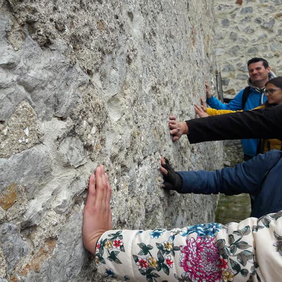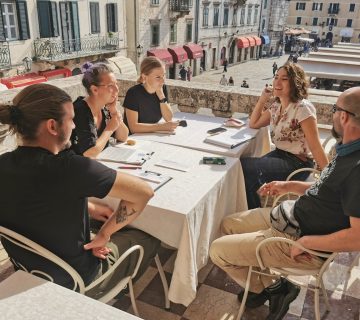The event was organised by Janja Sivec, the Country Coordinator for Slovenia, and her team. Zavod Celeia offered free use of the venues.
On the morning of 2 October, 48 heritage interpreters gathered at the Old Castle of Celje on the top of the castle hill. 14 of us were IE members, while the others came from similar organisations, working mainly in heritage promotion and tourism.
After the morning wake-up coffee we split into two groups. The first one was taken on a round tour of the castle by Carmen Klepej, an IE Certified Interpretive Guide. Using only the power of word, through story-telling, comparisons and other rhetorical stepping stones, Carmen managed to move us back through time to the year 1392. She painted for us a vivid picture of the castle kitchen, the family life of the Counts from Celje as well as their subsequent marriage contracts, their dynastic fights and their final tragedy.
Meanwhile, the second group was engaged in Janja’s workshop. Janja introduced two of the IE training courses: Certified Interpretive Guide (CIG) and the Certified Interpretive Host (CIH). She discussed the role of interpretation in conveying messages and the various types of heritage, such as tangible and intangible, mobile versus static, etc.
The two groups then swapped places. The first one attended Helena’s workshop, while the second one followed Carmen on a guided tour. Helena presented the Certified Interpretive Planner (CIP) course, the first of which was soon to take place in Rijeka, Croatia. We were encouraged to consider various aspects which need careful attention when planning any kind of interpretation, be it in the form of an exhibition, a thematic trail etc. We learned that balancing the space, the heritage, the management and the people involved can be quite a tricky process.
In the afternoon, we all moved from the castle hill to the town hall in the city centre. Janja and Helena introduced the Interpret Europe organisation and its activities. They recommended IE’s Altiero Spinelli prize-winning paper, Engaging citizens with Europe’s cultural heritage. The rest of the meeting was dedicated to cases of good practice from Slovenia. Lenka Stermecki from Zavod RS za varstvo narave introduced the geo-identity in the cross-border Karavanke UNESCO Global Geopark. Metka Starič from Zavod Parnas shared with us their latest project on the interpretation of culinary heritage. The architect Milan Kovač critically discussed the protection of the archaeological stone monuments in Celje. And finally, Marko Slapnik from Poseben dan, Zavod za pristna doivetja introduced the interpretation along the thematic route at Logarska dolina.
It was a busy day, packed with interpretation. It was also a day of socialising with our friends from IE and an opportunity to meet other interpreters from similar organisations. We enjoyed a nice atmosphere and gathered a lot of new information. At the end of the day at least three of the non-IE members were convinced by the IE approach and decided to join us and hopefully many more enjoyed their first introduction to IE and we will see them again in a professional capacity. Congratulations to Janja and Helena for a well-prepared event!
Vojka Cestnik is an archaeologist and a certified interpretive guide (CIG). A substantial part of her work has been dedicated to heritage interpretation at Vače, important archaeological site in Slovenia. She develops guided tours as well as live interpretation programmes. You can reach her at: vojkacestnik@yahoo.com.
To cite this article:
Cestnik, Vojka (2018) ‘Mine, yours, ours – the heritage interpretation meeting’. In Interpret Europe Newsletter 4-2018, 22.
Available online:
www.interpret-europe.net/fileadmin/Documents/publications/Newsletters/ie-newsletter_2018-4_winter.pdf




